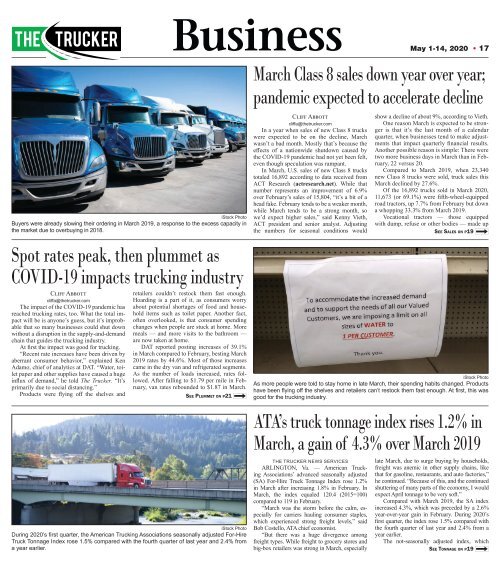050120_layout_AllPages
You also want an ePaper? Increase the reach of your titles
YUMPU automatically turns print PDFs into web optimized ePapers that Google loves.
iStock Photo<br />
Buyers were already slowing their ordering in March 2019, a response to the excess capacity in<br />
the market due to overbuying in 2018.<br />
Spot rates peak, then plummet as<br />
COVID-19 impacts trucking industry<br />
Cliff Abbott<br />
cliffa@thetrucker.com<br />
The impact of the COVID-19 pandemic has<br />
reached trucking rates, too. What the total impact<br />
will be is anyone’s guess, but it’s improbable<br />
that so many businesses could shut down<br />
without a disruption in the supply-and-demand<br />
chain that guides the trucking industry.<br />
At first the impact was good for trucking.<br />
“Recent rate increases have been driven by<br />
aberrant consumer behavior,” explained Ken<br />
Adamo, chief of analytics at DAT. “Water, toilet<br />
paper and other supplies have caused a huge<br />
influx of demand,” he told The Trucker. “It’s<br />
primarily due to social distancing.”<br />
Products were flying off the shelves and<br />
Business<br />
retailers couldn’t restock them fast enough.<br />
Hoarding is a part of it, as consumers worry<br />
about potential shortages of food and household<br />
items such as toilet paper. Another fact,<br />
often overlooked, is that consumer spending<br />
changes when people are stuck at home. More<br />
meals — and more visits to the bathroom —<br />
are now taken at home.<br />
DAT reported posting increases of 39.1%<br />
in March compared to February, besting March<br />
2019 rates by 44.6%. Most of those increases<br />
came in the dry van and refrigerated segments.<br />
As the number of loads increased, rates followed.<br />
After falling to $1.79 per mile in February,<br />
van rates rebounded to $1.87 in March.<br />
See Plummet on p21 m<br />
iStock Photo<br />
During 2020’s first quarter, the American Trucking Associations seasonally adjusted For-Hire<br />
Truck Tonnage Index rose 1.5% compared with the fourth quarter of last year and 2.4% from<br />
a year earlier.<br />
Cliff Abbott<br />
cliffa@thetrucker.com<br />
In a year when sales of new Class 8 trucks<br />
were expected to be on the decline, March<br />
wasn’t a bad month. Mostly that’s because the<br />
effects of a nationwide shutdown caused by<br />
the COVID-19 pandemic had not yet been felt,<br />
even though speculation was rampant.<br />
In March, U.S. sales of new Class 8 trucks<br />
totaled 16,892 according to data received from<br />
ACT Research (actresearch.net). While that<br />
number represents an improvement of 6.9%<br />
over February’s sales of 15,804, “it’s a bit of a<br />
head fake. February tends to be a weaker month,<br />
while March tends to be a strong month, so<br />
we’d expect higher sales,” said Kenny Vieth,<br />
ACT president and senior analyst. Adjusting<br />
the numbers for seasonal conditions would<br />
THE TRUCKER NEWS SERVICES<br />
ARLINGTON, Va. — American Trucking<br />
Associations’ advanced seasonally adjusted<br />
(SA) For-Hire Truck Tonnage Index rose 1.2%<br />
in March after increasing 1.8% in February. In<br />
March, the index equaled 120.4 (2015=100)<br />
compared to 119 in February.<br />
“March was the storm before the calm, especially<br />
for carriers hauling consumer staples,<br />
which experienced strong freight levels,” said<br />
Bob Costello, ATA chief economist.<br />
“But there was a huge divergence among<br />
freight types. While freight to grocery stores and<br />
big-box retailers was strong in March, especially<br />
May 1-14, 2020 • 17<br />
March Class 8 sales down year over year;<br />
pandemic expected to accelerate decline<br />
show a decline of about 9%, according to Vieth.<br />
One reason March is expected to be stronger<br />
is that it’s the last month of a calendar<br />
quarter, when businesses tend to make adjustments<br />
that impact quarterly financial results.<br />
Another possible reason is simple: There were<br />
two more business days in March than in February,<br />
22 versus 20.<br />
Compared to March 2019, when 23,340<br />
new Class 8 trucks were sold, truck sales this<br />
March declined by 27.6%.<br />
Of the 16,892 trucks sold in March 2020,<br />
11,673 (or 69.1%) were fifth-wheel-equipped<br />
road tractors, up 7.7% from February but down<br />
a whopping 33.3% from March 2019.<br />
Vocational tractors — those equipped<br />
with dump, refuse or other bodies — made up<br />
See Sales on p19 m<br />
iStock Photo<br />
As more people were told to stay home in late March, their spending habits changed. Products<br />
have been flying off the shelves and retailers can’t restock them fast enough. At first, this was<br />
good for the trucking industry.<br />
ATA’s truck tonnage index rises 1.2% in<br />
March, a gain of 4.3% over March 2019<br />
late March, due to surge buying by households,<br />
freight was anemic in other supply chains, like<br />
that for gasoline, restaurants, and auto factories,”<br />
he continued. “Because of this, and the continued<br />
shuttering of many parts of the economy, I would<br />
expect April tonnage to be very soft.”<br />
Compared with March 2019, the SA index<br />
increased 4.3%, which was preceded by a 2.6%<br />
year-over-year gain in February. During 2020’s<br />
first quarter, the index rose 1.5% compared with<br />
the fourth quarter of last year and 2.4% from a<br />
year earlier.<br />
The not-seasonally adjusted index, which<br />
See Tonnage on p19 m

















